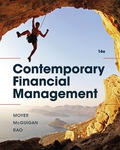
EBK CONTEMPORARY FINANCIAL MANAGEMENT
14th Edition
ISBN: 9781337514835
Author: MOYER
Publisher: CENGAGE LEARNING - CONSIGNMENT
expand_more
expand_more
format_list_bulleted
Question
Chapter 3, Problem 21P
a)
Summary Introduction
To discuss: Whether selling of new equity shares and use those proceeds to buy a new plant site will actually achieve the objective of improving liquidity of the company.
b)
Summary Introduction
To discuss: Whether using marketable securities and cash to pay-off accounts receivables and bank borrowings will actually achieve the objective of improving liquidity of the company.
c)
Summary Introduction
To discuss: Whether borrowing long-term debt and use those proceeds to pay off short-term debt will actually achieve the objective of improving liquidity of the company.
d)
Summary Introduction
To discuss: Whether selling the surplus fixed assets and use those proceeds to marketable securities will actually achieve the objective of improving liquidity of the company.
Expert Solution & Answer
Want to see the full answer?
Check out a sample textbook solution
Students have asked these similar questions
Need answer.
Solve plz now
Precious metal qn solve .
Chapter 3 Solutions
EBK CONTEMPORARY FINANCIAL MANAGEMENT
Ch. 3 - Prob. 1QTDCh. 3 - Prob. 2QTDCh. 3 - Prob. 3QTDCh. 3 - Prob. 4QTDCh. 3 - Prob. 5QTDCh. 3 - Prob. 6QTDCh. 3 - Prob. 7QTDCh. 3 - Prob. 8QTDCh. 3 - Prob. 9QTDCh. 3 - Prob. 10QTD
Ch. 3 - Prob. 11QTDCh. 3 - Prob. 12QTDCh. 3 - Prob. 13QTDCh. 3 - Prob. 14QTDCh. 3 - Prob. 1PCh. 3 - Prob. 2PCh. 3 - Prob. 3PCh. 3 - Prob. 4PCh. 3 - Prob. 5PCh. 3 - Prob. 6PCh. 3 - Prob. 7PCh. 3 - Prob. 8PCh. 3 - Prob. 9PCh. 3 - Prob. 10PCh. 3 - Prob. 11PCh. 3 - Prob. 12PCh. 3 - Prob. 13PCh. 3 - Prob. 14PCh. 3 - Prob. 15PCh. 3 - Prob. 16PCh. 3 - Prob. 17PCh. 3 - Prob. 18PCh. 3 - Prob. 19PCh. 3 - Prob. 20PCh. 3 - Prob. 21P
Knowledge Booster
Similar questions
arrow_back_ios
SEE MORE QUESTIONS
arrow_forward_ios
Recommended textbooks for you
 EBK CONTEMPORARY FINANCIAL MANAGEMENTFinanceISBN:9781337514835Author:MOYERPublisher:CENGAGE LEARNING - CONSIGNMENT
EBK CONTEMPORARY FINANCIAL MANAGEMENTFinanceISBN:9781337514835Author:MOYERPublisher:CENGAGE LEARNING - CONSIGNMENT Cornerstones of Financial AccountingAccountingISBN:9781337690881Author:Jay Rich, Jeff JonesPublisher:Cengage Learning
Cornerstones of Financial AccountingAccountingISBN:9781337690881Author:Jay Rich, Jeff JonesPublisher:Cengage Learning

EBK CONTEMPORARY FINANCIAL MANAGEMENT
Finance
ISBN:9781337514835
Author:MOYER
Publisher:CENGAGE LEARNING - CONSIGNMENT

Cornerstones of Financial Accounting
Accounting
ISBN:9781337690881
Author:Jay Rich, Jeff Jones
Publisher:Cengage Learning
